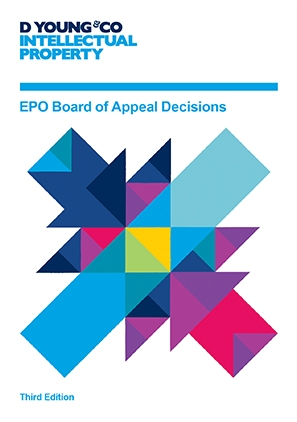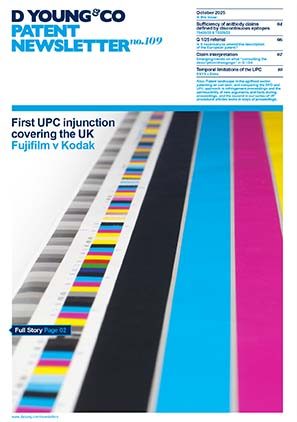Glaxo Group v Vectura: Arrow declarations
In a decision by Mr Justice Arnold, the English Patents Court has granted Glaxo Group (GSK) an Arrow declaration that its own manufacturing processes (and their direct products) were obvious over the prior art cited.
Building on the jurisprudence in Fujifilm v AbbVie and Generics v Yeda, this case provides useful guidance as to the availability of Arrow declarations (a valuable tool for some to clear the way).
What is an Arrow declaration?
An Arrow declaration is a declaration by the court that a party has a Gillette defence. The name derives from Arrow v Merck, the case which first considered the relief.
What is a Gillette defence?
In a Gillette defence a defendant contends that its (allegedly) infringing product or process was obvious at a particular date and accordingly cannot fall within a valid claim of a later patent. The name of the defence stems from Gillette Safety Razor Co v Anglo-American Trading Co.
Background
In 2010, Vectura granted GSK a licence in respect of one of its patents (referred to as Staniforth in the litigation) and any patents deriving from it. This related to manufacturing processes (and their direct products) for pharmaceutical compositions for inhalation using composite active particles with a magnesium stearate coating.
The agreement also identified an additional class of patent applications (referred to as “the non-assert patents”) in respect of which GSK had the option to take a licence.
The Staniforth patent expired in 2016 and subsequently GSK declined to take a licence under the non-assert patents.
In July 2016, Vectura commenced infringement proceedings in the US in relation to some of the US non-assert patents.
In turn, in June 2017, GSK sought to revoke five of Vectura’s UK non-assert patents.
GSK asserted that the patents were invalid for obviousness over certain prior art (including Staniforth) and insufficiency.
Vectura counterclaimed for infringement, which GSK denied.
In addition, GSK sought an Arrow declaration on the basis of a Gillette defence. GSK’s position was that it used an obvious development of the process disclosed in Staniforth and not the processes claimed in the patents in suit.
In a nutshell, GSK said that, although its process used magnesium stearate, this was disclosed by each of the three items of prior art.
Strike out application
Following commencement of the English proceedings, Vectura made an application to strike out GSK’s claim for Arrow relief. In doing so, Vectura gave an undertaking not to sue GSK under any of the remaining non-assert patents. Presumably, its logic being that, by removing a larger pool of patents from being in issue, this negated the need for an Arrow declaration to clear the way.
The application was unsuccessful, the Court of Appeal holding that it was for the trial judge to decide whether the relief was appropriate in light of the circumstances and facts at the trial date.
Subsequently, GSK identified a further patent relevant to the technical subject matter in suit owned by Vectura but which fell outside the scope of the definition of the non-assert patents. This was referred to as “415” in the litigation. GSK invited Vectura to give an undertaking not to sue in relation to this patent (or its divisionals). It declined.
Decision
The trial judge, Mr Justice Arnold, held that the patents were invalid for insufficiency, reasoning that it was not possible to determine when the patented invention had been performed (he declined to find them obvious). It followed that, if the patents were valid, infringement could not be established.
While Arnold J declined to find the patents in suit obvious, he did find that GSK’s processes were obvious in light of the prior art, concluding that GSK had a Gillette defence. It, therefore, fell to be determined whether the court would grant an Arrow declaration.
Arrow declaration
The principles upon which the court is prepared to grant such relief were considered by Mr Justice Carr in Fujifilm v AbbVie. Granting the relief, the court held that it should consider:
- justice to the claimant;
- justice to the defendant;
- whether the declaration will serve a useful purpose; and
- whether or not there are any other special reasons why the court should or should not grant the declaration.
As to point 4, Carr J noted that the attainment of commercial certainty in patent cases can constitute a useful purpose. The spin-off value of a judgment in other countries may be such a factor, but a declaration sought solely for the benefit of foreign courts will rarely be justified.
This was subsequently applied in Generics v Yeda. Here, the English Patents Court, declined to grant an Arrow declaration. The trial judge (again Arnold J) had found that the patent in suit in a particular dosing regimen was obvious. It followed that Generics’ product in issue was also obvious as it was identical to the patented regime.
The patent in suit was a divisional of another patent, and there were two pending divisional applications which covered the dosing regimen. Generics sought an Arrow declaration to clear the way in relation to these divisionals, but when asked by Arnold J why an Arrow declaration should have any greater persuasive value than a reasoned judgment on the validity of the patent in suit, Generics was unable to provide an answer. Consequently, Arnold J declined to grant the declaration, finding that it would not serve a “useful purpose”.
By contrast, in the case at hand, Arnold J concluded that a declaration would serve a useful purpose. Distinguishing his decision in Generics v Yeda, he reasoned:
“254. ... First, Vectura have failed to establish infringement of the Patents because they have not been able to identify a suitable analytical technique to demonstrate that certain requirements of the claims of the Patents are satisfied. Vectura would not necessarily face the same difficulty with differently formulated claims.
255. Secondly, I have not found that the Patents were obvious. It would be an open question as to whether patents with differently formulated claims were obvious or not.
256. Thirdly, and most significantly, Vectura has given an undertaking which is designed to give GSK comfort that, if they are successful in defeating Vectura’s claims for infringement of the Patents, then they will not be vexed by further claims for infringement of other patents by the same process and products; yet Vectura’s undertaking does not extend to patents deriving from (for example) 415. Counsel for Vectura was unable to give me any explanation for Vectura’s unwillingness to extend its undertaking to (at least) 415. It follows that GSK are potentially at risk of a claim for infringement of a patent deriving from (at least) 415.”
As a result, Arnold J granted a declaration as follows: “A declaration that the Claimants’ Processes described in the Annex A [which is the same as the PPD save for the fact that the particular Comil model (U5) is deleted] and the Claimants’ Products which are direct products of those Processes (and save for the active ingredients therein) were obvious as of 30 November 2000 or at any date thereafter.”
Case citations
- Gillette Safety Razor Co v Anglo-American Trading Co Ltd (1913) 30 RPC 465
- Arrow Generics v Merck [2007] EWHC 1900 (Pat)
- Fujifilm v AbbVie [2017] EWHC 395 (Pat)
- Generics v Yeda [2017] EWHC 2629 (Pat)
Case details at a glance
Jurisdiction: England and Wales
Decision level: High Court (Patents Court)
Parties: Glaxo Group Limited, Glaxo Operations Limited, GlaxoSmithKline Trading Services Limited (claimants) and Vectura Limited (defendant)
Citation: [2018] EWHC 3414 (Pat)
Date: 13 December 2018

